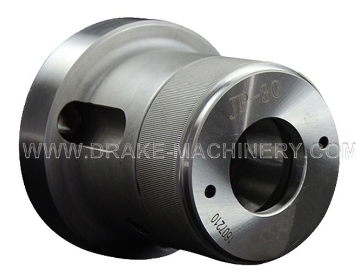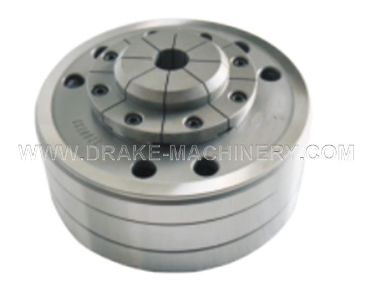The Benefits of Collet Chucks vs. Three-Jaw Chucks
Three-jaw chucks are the standard work holding device for most CNC lathe users. It is among the most widely used types of chuck in a variety of turning applications. However, that does not mean it is the best chuck for all jobs. A collet chuck is an alternate work holding device that also uses mechanical forces to hold a workpiece. While a collet chuck does not work with the same wide range of workpiece sizes that a jaw chuck can accommodate, it offers advantages in speed, accuracy, and productivity that may be crucial for certain jobs.
What is a Collet Chuck?
The standard work holding system that comes with most CNC lathes and turning centers consists of a three-jaw power chuck, a hydraulic actuating cylinder, and a drawtube. The hydraulic cylinder is attached to the rear end of the spindle, while the chuck is mounted to the spindle's front or working side. The cylinder and chuck are usually connected via a hollow, steel drawtube that passes through the spindle bore.
Similarly, a CNC collet chuck is mounted to the front of a CNC lathe spindle, using the machine's existing cylinder and drawtube to actuate:
The axial motion of the hydraulic actuator's piston is what causes the collet chuck's jaws to open and close. The drawtube moves in unison with the piston, driving a wedge-shaped plunger within the chuck body as the piston slides back and forth. The plunger, in turn, converts axial motion to radial motion, accomplishing the opening and closing of the jaws. The gripping force of the jaws to a workpiece corresponds directly to the output of the actuator; thus, this force is easily regulated via a pressure valve.
Of course, a collet chuck requires a collet to function. Typically, collets have something like a 0.062” gripping range. Collets are readily available for round, hex, and square stock. A collet chuck can handle a fairly wide range of collets (e.g. 3/16” all the way through to 2-5/8”). Special collet requirements can be accommodated. Most modern collet chucks have a quick (e.g. 10 seconds) change functionality for reduced set-up times.
When is a Collet Chuck a Better Choice than a Three-Jaw Chuck?
ㆍBar Feeding: Collet chucks are ideal for machines equipped with bar feeders because they provide full 360° contact, ensuring that the bar stock remains on centerline and allowing for accurate re-gripping after being advanced. A collet chuck also helps to minimize vibration, and opens and closes faster than a three-jaw chuck.
ㆍSmall Diameter Work: Collet chucks offer much better tool clearance for small parts ranging in size from 1/16″ to 4″ in diameter. Collet chucks can also be run at higher speeds, and provide superior gripping force, than three-jaw chucks.
ㆍShort / Thin Parts: A collet chuck's low-profile design provides better tool clearance and allows for machining very close to the chuck face, which helps prevent thin parts from sagging or bending.
ㆍHigh Speed Operation: Compared to three-jaw chucks, collet chucks hold up far better to the negative effects of centrifugal force. This allows collet chucks to run at higher speeds with consistent gripping force.
ㆍReduced Setup Times: A collet can be changed much faster than chuck jaws, and without boring. Collet chucks keep your machines making chips - and profits!
Pipe and Tube Work: Collets provide 360° contact with the part, distributing the gripping force evenly around the part's entire circumference and reducing the risk of crushing or distorting thin-walled parts.
ㆍOdd Shaped Parts: With a bit of customization, collets can easily be made to hold off-shaped or off-center parts. There is a wide selection of standard collets designed for round, square, and hex stock.
ㆍBetter Tool Life: The paddlewheel-like shape of a three-jaw chuck can deflect coolant before it reaches the cutting tool tip, shortening tool life, whereas the streamlined shape of a collet chuck enables precise coolant delivery. Collet chucks also produce far less mist than three-jaw chucks.
For more information about the benefits of collet chucks and help to select the right work holding device for your operation, contact us.




